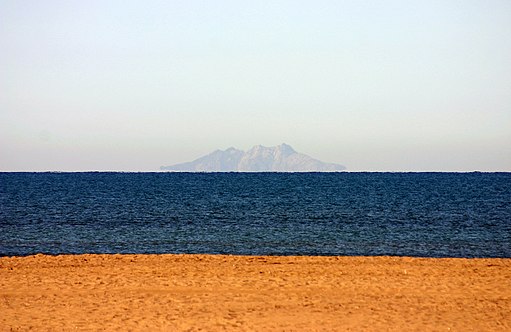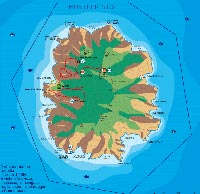The island of Montecristo, the beach of Cala Maestra
|
Montecristo was made famous by the French novelist Alexandre Dumas in his classic The Count of Monte Cristo, a story of revenge, honour and buried treasure.
|
Island of Monte Cristo nature reserve Nowadays the island has only two permanent human inhabitants, both nature reserve keepers. In addition, agents of the State Forestry Corps from Follonica live there in alternating shifts of two weeks at a time.[1] The state nature reserve Isola di Monte Cristo is a biogenetic reserve of 1,039 hectares established in 1971 by ministerial decree to protect the unique nature of the island.[1] Today it belongs to the Tuscan Archipelago National Park. It was also awarded the European Diploma of Protected Areas in 1988,[2] and recognized as a site of pan-European interest.[3] Visitors face a number of restrictions. It is not possible to stay overnight, and fishing, swimming, and surfing is prohibited within 1,000 meters of the coast. It is possible to cruise within three miles (4.8 km)of the coast, but not to fish. Access by sea can take place only at Cala Maestra, where the seabed is sandy, with an approach course perpendicular to the coast; it is possible to dock at the pier or tie up against a buoy, but dropping anchor is not allowed; there is also a small heliport for emergencies. To visit the island, one must apply for access at the Forestry Corps in Follonica. Visitors with basic authorisation must stay at Cala Maestra, and can visit only the Royal Villa, the botanical garden, and the museum. The waiting list for access is long, since an upper limit has been set of only 1,000 visitors per year. The average waiting time for approval is three years; priority is given to scientific expeditions, associations, and schools. Tours take place only on the three existing trails, all very challenging.[4]
|
Landmarks
|
||||
San Mamiliano Around the middle of the fifth century AD, the caves of the island became home to several hermits escaping from the Vandals of Genseric, the most important of whom was St. Mamilian. They christened the island Mons Christi, from which the modern name is derived.
|
||||
|
|
||||
 |
 |
 |
||
Ruins of the Monastery of San Mamiliano [2]
|
Chapel and Cave of San Mamiliano on Montecristo | The island of Montecristo view from the chapel Notre-Dame des Grâces, Tox, Castagniccia (Corsica) |
||
 |
 |
|||
Hobart Bosworth (right) in The Count of Monte Cristo (film 1908)
|
Montecristo | The beach Cala Maestra |
||
Map of Montecristo | Map
|
||||
[1] Photo by Sailko, licensed under the Creative Commons Attribution-Share Alike 3.0 Unported license.
|
|
|||
| Questo articolo è basato sull'articolo Montecristo dell' enciclopedia Wikipedia ed è rilasciato sotto i termini della GNU Free Documentation License | ||||
